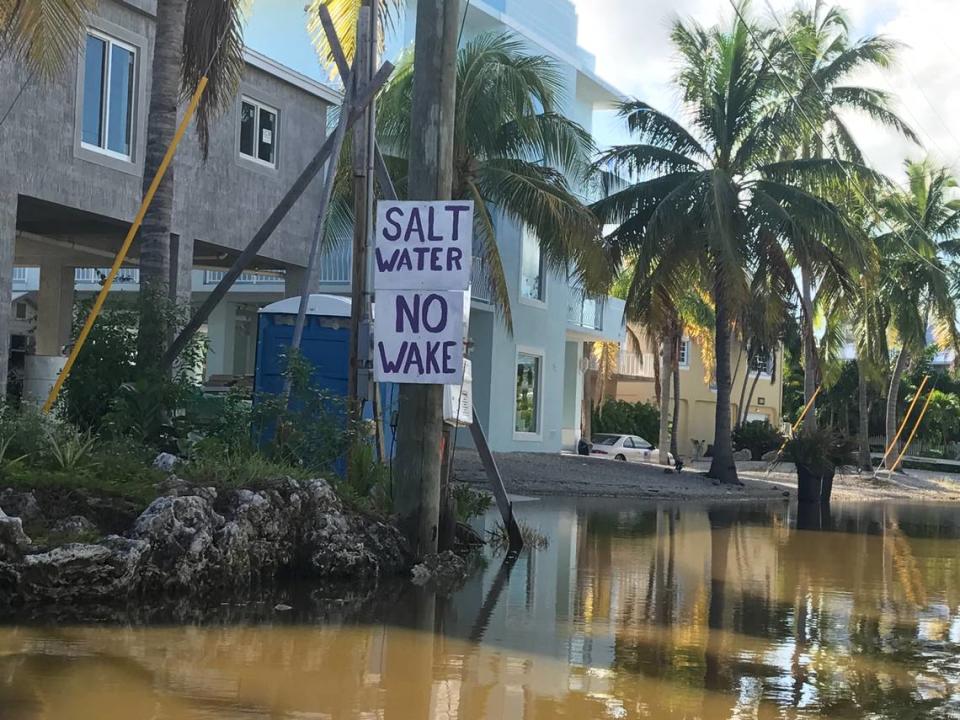Hurricane Ian is coming when king tides will be in Florida. What to know about high tides
If you know anything about South Florida’s climate, it’s that September marks the start of the annual cycle of high tides known as king tides.
READ MORE: It’s king tide season again. Here’s when (and where) Miami could see high tide flooding
And the convergence of Hurricane Ian with king tide season means extra concern about more flooding around the state. Hurricane Ian is expected to pass west of the Florida Keys late Tuesday and make its way up the west coast of Florida by the end of the week.
READ MORE: Where is Hurricane Ian and when will Florida start to feel it? What the forecast shows
Here’s what you need to know about king tide and its effects on South Florida ahead of the storm.
What is king tide?
King tide is when the tides are at the highest in the season. These high tides are a natural occurrence during new and full moons but are exacerbated by climate change.
These tides can push sea levels a foot or two higher than normal, which causes flooding in low-lying spots along the east coast, like Miami.
How could Ian impact king tide?
While Ian isn’t projected to directly hit South Florida, the region will likely be impacted by the storm, including flooding exacerbated by king tide.
Good news: Miami-Dade is no longer in the cone of concern for Tropical Storm Ian.
We do expect heavy rain and possible tropical storm winds, along with King Tide—which could be exacerbated by storm conditions.
Residents & visitors, please remain vigilant for inclement weather.— Daniella Levine Cava (@MayorDaniella) September 25, 2022
READ MORE: Ian likely won’t head to South Florida but could make an impact. Here’s how — and why
The Miami Beach Division of Emergency Management is monitoring Hurricane Ian. Although Miami Beach is not within the forecasted cone of concern, we could still experience some impacts, including flooding which may be exacerbated by king tides.
Read more: https://t.co/t3WRT2PCM7 pic.twitter.com/kQ67eKQth7— City of Miami Beach (@MiamiBeachNews) September 26, 2022
Tides will be a little higher than normal for southeast Florida, said Jamie Rhome, acting director of the National Hurricane Center. And they’ll be “disruptive in certain areas, but not rise to the level of life-threatening.”
Areas at risk for flooding include coastal cities off the Atlantic and Intracoastal Waterway, such as Miami Beach and Fort Lauderdale Beach, said Chuck Caracozza, a meteorologist at the National Weather Service in Miami.
“Basically any coastal city is vulnerable,” Caracozza said.
Flooding in South Florida will be minor and will mainly impact low-lying roads, Caracozza said.
Rhome singled out the Keys as somewhere higher storm surge levels could make a difference.
”That has the potential to be a pretty impactful event down there because it could cut off roads,” he said.
During king tide season, streets on some residential areas of the Keys, including Florida Bay neighborhoods in Key Largo, are flooded to the point that residents can’t drive through. One Keys neighborhood saw 90 straight days of flooded streets during 2019’s king tide season.

The NHC expects that life-threatening storm surge associated with Hurricane Ian is possible along the Florida west coast starting late Tuesday.
Rhome also noted that the higher than usual king tides are already accounted for in the NHC’s predictions and do not need to be added on.
Life-threatening storm surge associated with Hurricane Ian is possible along the Florida west coast beginning late Tuesday. Residents in these areas should listen to advice from local officials. As forecasts may evolve, visit https://t.co/0BMJEA5Wz0 for the latest on #Ian. pic.twitter.com/idIpTbKTYN
— NHC Storm Surge (@NHC_Surge) September 26, 2022
When will South Florida expect king tide?
According to Miami-Dade County, king tides are expected on Tuesday and Wednesday, Sept. 27-28, when Hurricane Ian is projected to be off the waters off Key West and then head up the west coast of Florida. The tides are also predicted for Oct. 7-12, Oct. 24-28 and Nov. 6-9.
What should I know to stay safe during floods?
Avoid walking through flood water because it can contain live electrical wires. It also contains pollutants that can be damaging to your health. If you need to, wash your hands and clothes after.
Avoid driving through flooded areas. This can threaten your safety and damage your vehicle. Boaters should check the tide before leaving the dock. Bridges may have lower clearance.
Check with your city government. They may have additional resources available.
The City of Miami Beach offers free temporary parking during king tides if you live within the prescribed flood zone areas.
Miami Beach residents can also report property and roadway flooding by calling 305-673-7625 or emailing flooding@miamibeachfl.gov.
Anyone who notices standing water for more than 48 hours should call the Miami Beach control room at 305-673-7625. It is important to drain and cover standing water to avoid mosquito-borne disease.
Miami Herald staff writer Alex Harris contributed to this report.

 Yahoo Movies
Yahoo Movies 